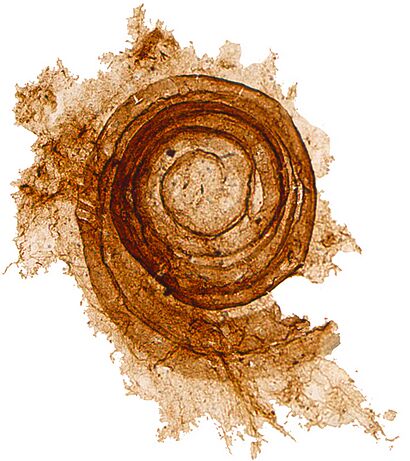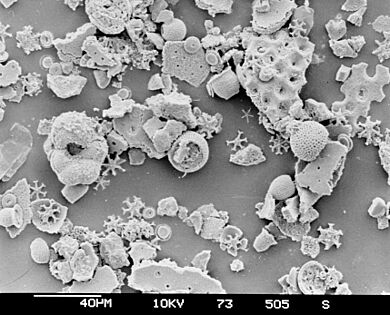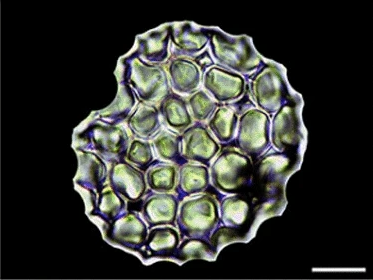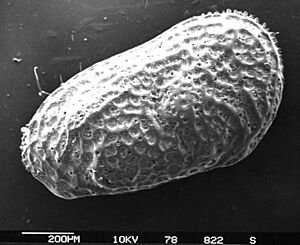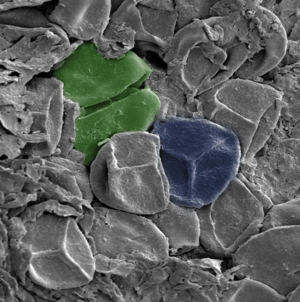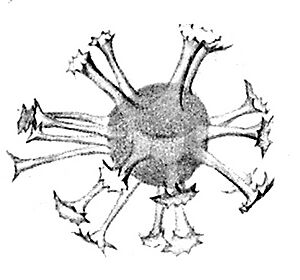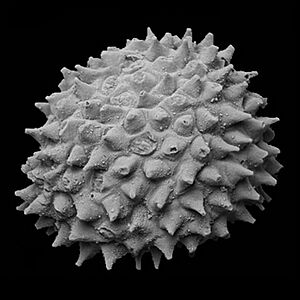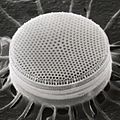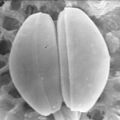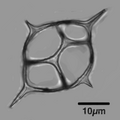Microfossil facts for kids
A microfossil is a very tiny fossil, usually smaller than a grain of sand. They are so small that scientists need a powerful microscope to see them. Fossils big enough to see with your eyes, like dinosaur bones, are called macrofossils.
Microfossils are the remains of tiny life forms like protists, pollen grains, or even tiny parts of larger animals. They are found all over the world in rocks and sediments. They are very common in material from the bottom of the ocean.
These tiny fossils are super important. They help scientists learn about what Earth was like millions of years ago. They can tell us about past climates and ancient oceans. In 2017, scientists found microfossils in Canada that might be over 4 billion years old. This could be the oldest evidence of life on Earth!
Contents
Fossils as Time Markers
Some microfossils are like time markers for rock layers. These are called index fossils. They help scientists figure out the exact age of a rock.
To be a good index fossil, the creature must have:
- Lived over a wide area of the world.
- Only existed for a short period of time in Earth's history.
- Evolved quickly.
When scientists find the same index fossil in rocks in different parts of the world, they know the rocks are the same age. Many types of microfossils, like foraminifera and conodonts, are used as index fossils.
What Are Microfossils Made Of?
Microfossils can be made of different materials. Scientists often group them based on what their tiny skeletons or shells are made of.
Glassy Skeletons (Silica)
Some microfossils are made of silica, which is the main ingredient in glass. These tiny skeletons are beautiful and have complex shapes.
- Diatoms are tiny algae that build glassy shells called frustules. They are so common that thick layers of their fossils form a soft rock called diatomaceous earth.
- Radiolarians are single-celled creatures that also build detailed silica skeletons.
- Phytoliths are "plant stones." Plants absorb silica from the soil, which forms hard structures inside their cells. These tiny silica bits can become fossils.
- Sponge spicules are tiny, sharp structures that form the skeleton of a sponge. They can be made of silica and look like tiny needles or stars.
|
|
|||||||
|---|---|---|---|---|---|---|---|
| mineral forms |
protist involved |
name of skeleton | typical size | ||||
| SiO2 silica quartz glass opal chert |
diatom |  |
frustule | 0.002 to 0.2 mm | 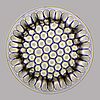 |
A diatom microfossil from 40 million years ago. | |
| radiolarian |  |
test or shell | 0.1 to 0.2 mm | 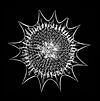 |
The beautiful silica shell of a radiolarian. | ||
Chalky Shells (Calcium Carbonate)
Other microfossils are made of calcium carbonate, the same mineral found in chalk, limestone, and seashells.
- Foraminifera (or "forams") are protists that make shells, called tests. When they die, their shells can pile up on the ocean floor.
- Coccolithophores are algae that cover themselves with tiny plates called coccoliths. These are so tiny that millions can fit on the head of a pin. The famous White Cliffs of Dover in England are made almost entirely of these microfossils.
- Ostracods, or "seed shrimp," are tiny crustaceans with a bean-shaped shell made of calcium carbonate.
|
|
|||||||
|---|---|---|---|---|---|---|---|
| mineral forms |
protist involved |
name of skeleton | typical size | ||||
| CaCO3 calcite aragonite limestone marble chalk |
foraminiferan |  |
test or shell | many under 1 mm | 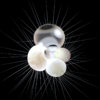 |
The chalky shell of a foram. There are about 10,000 living species. | |
| coccolithophore |  |
coccoliths | under 0.1 mm |  |
Coccolithophores are a huge source of calcium carbonate and are the main part of chalk deposits. | ||
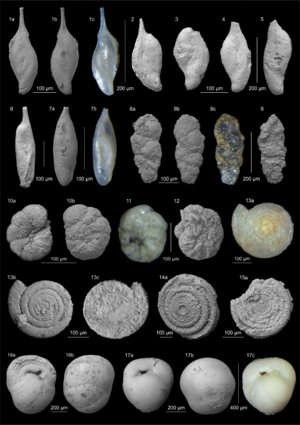
Tough Organic Fossils
Not all fossils are made of minerals. Some are made of tough organic materials that don't easily rot away. The study of these is called palynology.
- Pollen grains have a very tough outer wall. Plants produce huge amounts of pollen, and it fossilizes well. By studying fossil pollen, scientists can learn what kinds of plants lived in an area and what the climate was like.
- Spores are similar to pollen and are produced by plants like ferns, as well as fungi and algae. They are some of the oldest fossils of land life.
- Dinoflagellate cysts are a "sleeping" stage for some types of algae called dinoflagellates. When conditions are bad, they form a tough-walled cyst that can survive and later become a fossil.
More Amazing Microfossils
Mysterious Ancient Life
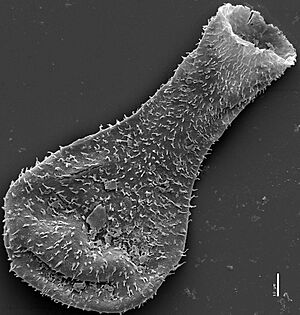
Some microfossils are very strange, and scientists are still trying to figure out what they are.
- Chitinozoa are tiny, flask-shaped fossils. For a long time, no one knew what kind of creature made them. They might be the ancient eggs of a sea animal or the shell of a mysterious protist.
- Acritarchs are even more mysterious. The name means "confused origins." They are a group for any small, organic-walled fossil that can't be identified. They are some of the oldest fossils of complex life on Earth.
The First Armor
The cloudinids were some of the first animals to build hard, protective shells. These tiny, cone-shaped fossils appeared about 550 million years ago. They looked like a stack of ice cream cones.
Some Cloudina fossils have holes in them. Scientists think these holes were made by predators! This is some of the first evidence of animals hunting other animals, which may have led to the Cambrian explosion of new life forms.
Tiny Teeth and Jaws
- Conodonts are the tiny, tooth-like fossils of an extinct, jawless fish that looked like an eel. For many years, scientists only found the teeth and had no idea what the animal looked like. Conodont teeth are made of a phosphatic mineral and are some of the sharpest teeth ever recorded.
- Scolecodonts are the fossilized jaws of ancient worms. Since the worms' soft bodies rarely fossilized, these tiny, hard jaws are often the only evidence we have of them.
Where Are Microfossils Found?
Microfossils are found in sedimentary rocks all over the world. They are especially common in marine sediments at the bottom of the ocean.
There are two main types of ocean sediment. One type comes from eroded rock from land. The other type, called biogenous sediment, is made of the skeletal remains of tiny sea creatures.
When tiny organisms with silica or calcium carbonate shells die, they sink to the ocean floor. Over millions of years, these shells build up in thick layers, forming a soft mud called an ooze. This ooze eventually hardens into rock, like limestone or chert, trapping the microfossils inside.
Studying Tiny Fossils
The study of microfossils is called micropaleontology. Micropaleontologists are scientists who use microscopes to find and study these tiny treasures.
Their work is very important. Microfossils can:
- Help date rocks and find resources like oil and gas.
- Tell us about past climates and how they have changed over time.
- Show us how life on Earth has evolved.
Microfossils can even show up in surprising places. The stone dagger of Ötzi the Iceman, a man who lived over 5,000 years ago, was made of a type of rock called chert. Scientists found microfossils inside the chert, which helped them trace the rock to where it came from.
Images for kids
-
The stone dagger of Ötzi the Iceman. The blade is made of chert that contains microfossils, which helped scientists learn about its origin.
-
Three main types of Archean cell morphologies
-
The fossil remains of an ancient cyanobacteria. Scale bar is 100 micrometers.
-
Diatomaceous earth is a rock made of the fossilized shells of diatoms.
-
A fossil Radiolarian.
See also
- Biosignature
- Biostratigraphy
- Chemostratigraphy
- Gunflint microfossils
- Macrofossil
- Protists in the fossil record
- Protist shell
- Scale microfossils
- Small carbonaceous fossil


